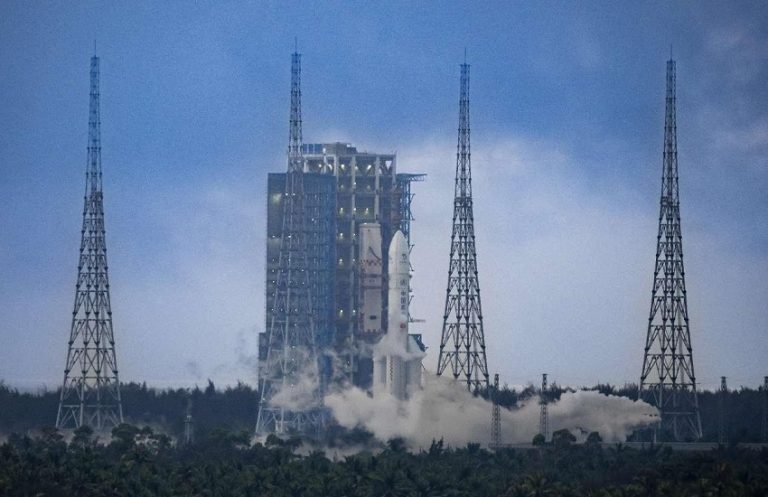
By Yu Sinan, Wang Jingyuan, At 5:27 p.m. (Beijing Time), May 3, China’s Chang’e-6 spacecraft blasted off at the Wenchang Space Launch Site on the coast of China’s southern island province of Hainan.
As an important mission of the fourth phase of China’s lunar exploration program, Chang’e-6 will collect and return samples from the moon’s mysterious far side — the first endeavor of its kind in the history of human lunar exploration.
According to Wang Qiong, deputy chief designer of the Chang’e-6 mission, the mission needs to see new technological breakthroughs in such areas as lunar retrograde orbit design and control, rapid intelligent sampling, and takeoff from the far side of the moon. It will conduct an automated sample return from the moon’s far side, along with scientific exploration of the landing area and international collaboration.
Wang said the scientific goals of the Chang’e-6 mission include on-site investigation and analysis of the landing area on the far side of the moon and the analysis and study of the samples retrieved from the far side.
The entire flight of the mission is expected to last about 53 days, during which the spacecraft will experience 11 flight stages, including launch and orbit insertion, and lunar transfer, among others.
The fourth phase of China’s lunar exploration program consists of the Chang’e-4, Chang’e-6, Chang’e-7, and Chang’e-8 missions. In January 2019, the Chang’e-4 probe touched down at the target landing area on the far side of the moon, becoming the first spacecraft soft-landing on the moon’s uncharted side that is never visible from Earth.
The Chang’e-6 mission marks another step forward in China’s lunar exploration program. It has garnered widespread attention for its goal to retrieve samples on the far side of the moon.
Studying lunar samples from different regions and ages can help humans learn more about the moon. However, all 10 lunar sample return missions conducted by humans by far have taken place on the near side of the moon.
The South Pole-Aitken Basin on the far side of the moon was chosen as the target landing and sampling site for the Chang’e-6 mission. The basin is one of the largest impact craters known in the solar system, one of the three major lunar terranes, and the largest, oldest, and deepest basin recognized on the moon. It might be home to aged lunar rocks, making it highly valuable for scientific research.
After the Chang’e-6 spacecraft retrieves lunar samples from the far side of the moon, scientists are expected to carry out systematic and long-term laboratory research on the samples, including analysis of the structure, physical properties, and composition of lunar soil, which will enhance humanity’s understanding of the formation and evolution of the moon.
The rugged terrain of the moon’s far side poses great challenges for its landing. Wang noted that scientists can obtain basic information about the landing site through satellite remote sensing images, but detailed conditions remain unknown. For instance, the landing could be affected by certain rocks on the lunar surface. Therefore, technological means are necessary to adjust the spacecraft’s landing trajectory to ensure it reaches the desired landing area during the descent. Once the lunar mission is completed, the Chang’e-6 will embark on its journey back home.
Practical international collaboration is one of the distinctive features of the Chang’e-6 mission. It is reported that in April 2019, China announced a cooperation plan for the Chang’e-6 mission, and decided to carry four payloads developed through international cooperation with the spacecraft, including the European Space Agency’s lunar surface ion analyzer, France’s radon detection instrument, Italy’s laser corner reflector, and a CubeSat from Pakistan.
On May 3, the China National Space Administration (CNSA) convened a workshop focusing on the international payloads carried by Chang’e-6 in Haikou, south China’s Hainan province. Around 50 guests from 12 countries and international organizations were invited to attend the workshop, discuss cooperation, and witness the launch of the spacecraft.
Hu Hao, chief designer of the Chang’e-6 mission, noted that China places great importance on international cooperation in developing its lunar exploration program, and is committed to keeping the door open for collaboration with the international community.
It is reported that China is currently speeding up the development of the International Lunar Research Station (ILRS). Recently, three new partners have joined the ILRS program, namely Nicaragua, the Asia-Pacific Space Cooperation Organization, and the Arab Union for Astronomy and Space Sciences.










